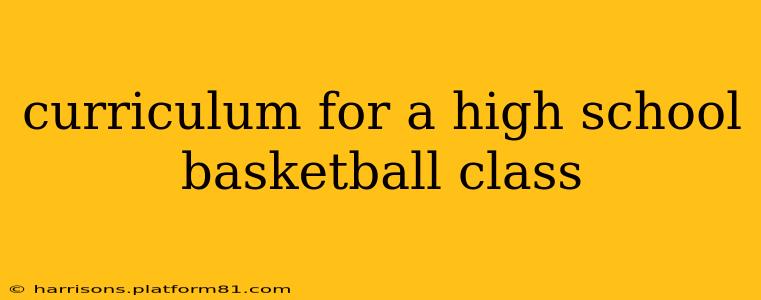This curriculum outlines a comprehensive high school basketball class designed to develop fundamental skills, strategic understanding, and a lifelong appreciation for the sport. It caters to students of all skill levels, emphasizing teamwork, sportsmanship, and personal growth alongside athletic development.
Course Objectives: Upon completion of this course, students will be able to:
- Demonstrate proficiency in fundamental basketball skills (dribbling, passing, shooting, defense).
- Understand and apply basic basketball strategies and offensive/defensive schemes.
- Analyze game situations and make informed decisions on the court.
- Exhibit good sportsmanship, teamwork, and leadership qualities.
- Appreciate the history and cultural impact of basketball.
- Improve physical fitness and overall health.
Course Structure: The course will utilize a blended learning approach, combining practical drills and scrimmages with theoretical learning and discussions. The curriculum is divided into units, each focusing on a specific aspect of the game.
Unit 1: Fundamental Skills (4 Weeks)
- Dribbling: Various dribbling techniques (low, high, between the legs, behind the back), ball-handling drills, and individual practice.
- Passing: Chest passes, bounce passes, overhead passes, accuracy and speed drills, and partner work.
- Shooting: Proper shooting form, free throws, jump shots, layups, shot selection drills, and game-like scenarios.
- Defense: Basic defensive stances, footwork, guarding techniques, and defensive drills.
- Conditioning: Agility drills, running drills, and strength training focused on basketball-specific movements.
What are the benefits of practicing basketball fundamentals?
Practicing basketball fundamentals builds a solid foundation for improvement. Mastering the basics allows players to execute more complex plays effectively. It also improves efficiency, accuracy, and reduces the risk of injury. Strong fundamentals provide a baseline for players to develop their individual style and advance to higher skill levels.
Unit 2: Offensive and Defensive Strategies (4 Weeks)
- Offensive Strategies: Basic offensive sets, motion offense, pick-and-roll plays, cutting, screening, and fast breaks.
- Defensive Strategies: Man-to-man defense, zone defense, help defense, defensive rotations, and rebounding techniques.
- Game Analysis: Film study of professional games, identifying strategies and techniques.
- Teamwork Drills: Drills focusing on communication, collaboration, and strategic execution during both offensive and defensive scenarios.
How important is teamwork in basketball?
Teamwork is paramount in basketball. It's a team sport that relies heavily on communication, coordination, and trust between players. Successful teams work together seamlessly, supporting each other on both ends of the court. Teamwork leads to better strategy execution, improved player performance, and overall success.
Unit 3: Game Situations and Decision-Making (3 Weeks)
- Scenario-Based Drills: Simulations of various game situations to practice decision-making under pressure.
- Game Strategy Discussions: Analysis of successful and unsuccessful plays and strategies.
- Leadership Development: Discussions on leadership roles, communication skills, and conflict resolution.
- Refereeing and Rules: Understanding basic basketball rules and refereeing signals.
How do I improve my basketball decision-making?
Improving basketball decision-making involves analyzing game situations quickly, understanding your team’s strengths and weaknesses, and recognizing your own limitations. Regular practice and film study help develop this skill. By understanding what your opponents are doing and anticipating their next move, you can improve decision-making and contribute positively to team success.
Unit 4: History and Culture of Basketball (2 Weeks)
- History of Basketball: Exploring the origins of basketball, significant players, and milestones in the sport’s history.
- Cultural Impact of Basketball: Discussing basketball's influence on society, its role in different cultures, and its impact on communities.
- Professional Basketball: Learning about the structure of professional leagues, different playing styles, and famous athletes.
What is the history of basketball?
Basketball was invented in 1891 by James Naismith. It quickly gained popularity, becoming a globally recognized sport. Its evolution has seen changes in rules, techniques, and style, but its core principles remain the same: teamwork, skill, and athletic competition.
Assessment: Student progress will be assessed through participation in class activities, skill demonstrations, written assignments, game performance, and a final project (e.g., a research paper on a historical figure in basketball, or a presentation on a specific team's strategy).
Note: This curriculum is a suggestion and can be adapted to suit the specific needs and skill levels of the students. Flexibility and adjustments based on student progress are encouraged.
